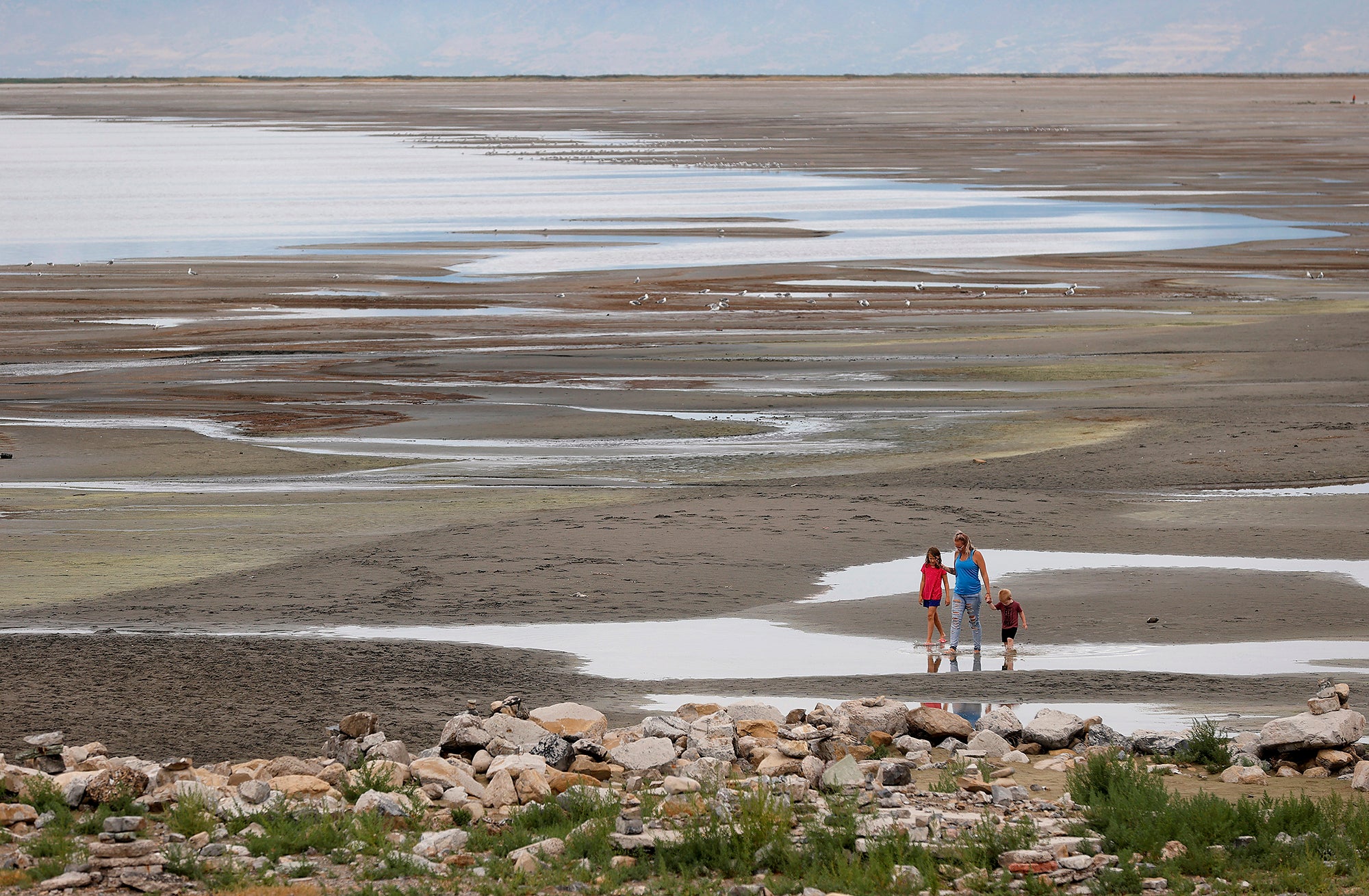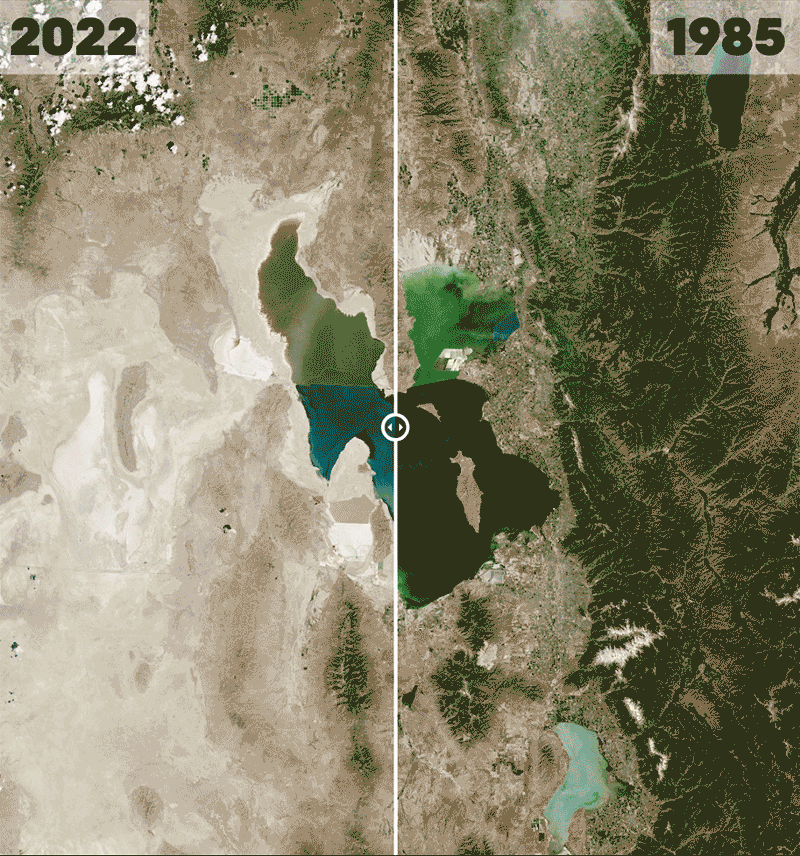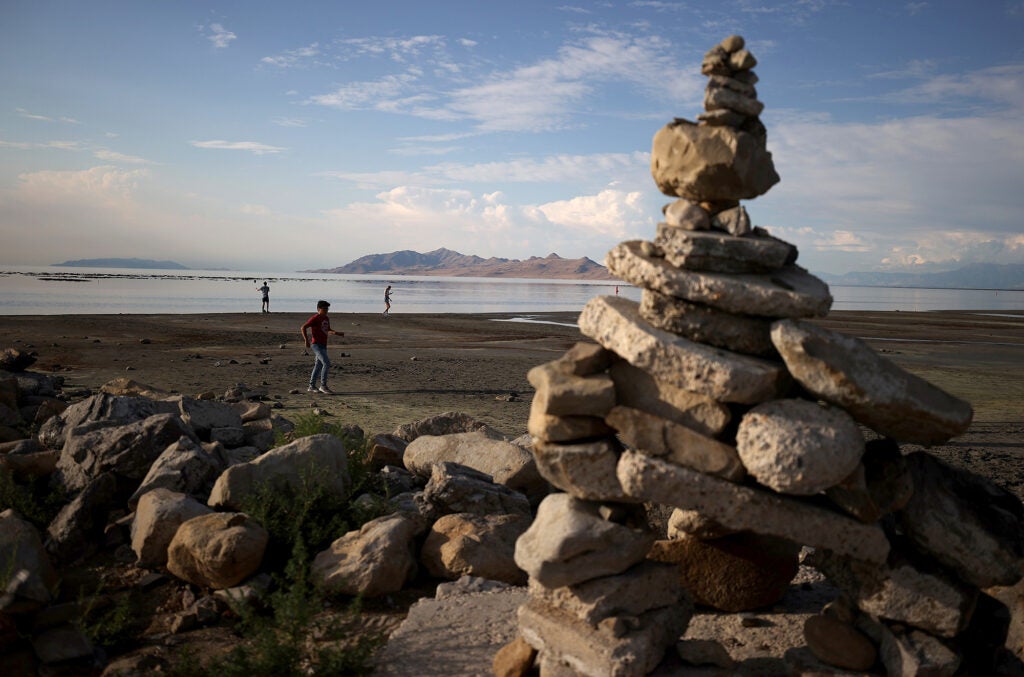We’re Suing to Save the Great Salt Lake From Going to Dust
Millions of people could wind up breathing in toxic dust from newly exposed lakebed.

What would Salt Lake City be without the Great Salt Lake?
As far back as people can remember, the Great Salt Lake has been a wonder to drive past, a stopover for 10 million migratory birds as majestic as the American white pelican, a scenic backdrop for family ski vacations, and a boon to the local economy.
If the lake continues to shrink, its two main food chains (brine shrimp and flies) will collapse, threatening one of North America’s largest migratory bird colonies. Then there’s the impending public health crisis, the question of what will happen when millions of people breathe in toxic dust from the newly exposed lakebed. As water levels recede, mercury and arsenic in the lakebed — once safely underwater but now above ground — are sent into the air each time strong winds blow. One Republican lawmaker said the state is sitting on “an environmental nuclear bomb” if state officials don’t take action.
That’s why Earthjustice filed suit last fall on behalf of conservation and community health groups who argue that the state has violated its obligation to save the lake under the public trust doctrine.

Satellite view of the Great Salt Lake in Utah in June 1985 (right) compared to July 2022. (NASA Earth Observatory)
The public trust doctrine dates back to Roman law. It means, in the words of Earthjustice attorney Scott Stern, “There are certain resources that are so important that they can’t be owned by individuals. Instead, they belong to the public and the state has an obligation to protect them.”
The lake — and other major bodies of water — are part of this public trust under Utah state law. But the state now claims waters are somehow outside the public trust and is trying to get the lawsuit dismissed on that basis. This argument is essentially unprecedented in the U.S. — no court in the country has embraced the state’s position.
In April 2024, Earthjustice submitted a 135-page response to keep the case in play. Three dozen professors submitted an amicus brief supporting the argument that the Great Lake is covered under public trust.
“The state clearly has the authority to undertake water conservation measures necessary to restore the Lake,” the professors wrote. “Directing the state to fulfill its public trust obligation by developing and enforcing a plan […] to restore the Lake is certainly within the authority of this Court.”
Vanishing Oasis from YaleE360, directed and produced by Jaxon Derow.
Instead of using its authority to ensure enough water flows to the lake to sustain its minimum healthy elevation of 4,198 feet, Utah lets two-thirds of the river and stream water that feeds the lake be diverted. Policymakers tend to treat Utah’s water supplies as bountiful, creating subsidies that give Utah the cheapest water in the country. According to Zach Frankel of the Utah Rivers Council, one of the groups that brought the case, more than two-thirds of Utah’s water goes to growing alfalfa and hay (crops that are not sustainable, native to the region, or even consumed in significant quantities in the U.S.); mining projects; and watering grass on people’s lawns and off-ramps on the highway.
“There’s a cornucopia of easy solutions to put water in the Great Salt Lake,” he says.
Reducing upstream water diversions is essential. He claims this along with low water landscaping, following the conservation policies nearby states do, and using canals rather than pipes to irrigate farms would supply the city and nearby farms with all the water they need without endangering the lake.
But if nothing’s done, Utahns are facing a public health disaster. As lake levels decline, salt concentrations rise until even the shrimp and flies at the base of the food chain can no longer survive. Birds will start to starve to death. And they’re not the only ones in danger.
Earlier this year, 300 medical professionals delivered a letter to Utah policymakers warning that unless enough water reaches the Great Salt Lake to reverse its decline, a serious public health crisis will plague the state’s future.
“Thousands of studies from around the world, including from Utah, have definitively concluded that air pollution, including lakebed dust, is a serious health hazard,” they wrote.
The consequences they outlined included decreased life expectancy, heart and lung disease, increased risk of strokes, neurologic and endocrine diseases, and birth defects.
The Great Salt Lake’s lakebed contains toxic heavy metals such as mercury and arsenic, exposure to which are linked to adverse neurological and developmental impacts. These neurotoxins are already becoming airborne in the form of dust. And the potential for a massive toxic dust storm grows as the lake dries up and exposes greater areas of the lakebed.
Today, Salt Lake City gets about 15 dust storms a year, compared to none 15 years ago. As many as 2.5 million people live within range of these storms — many of them on the city’s west side, where a majority of residents are people of color. Environmental justice advocates are outraged, saying those with wealth can relocate elsewhere while everyone else will be forced to endure the life-altering consequences.

Park visitors walk by a rock formation on the banks of the Great Salt Lake at the Great Salt Lake State Park in 2021. (Justin Sullivan / Getty Images)
In other places salt lakes have dried up, the results have been disastrous, according to Dr. Brian Moench of Utah Physicians for a Healthy Environment. For example, toxic dust from the bed of Central Asia’s Aral Sea, formerly the fourth-largest saline lake in the world and now almost completely desiccated, has created a cluster of health crises for people nearby.
“In Uzbekistan child mortality has skyrocketed,” Moench says. “Respiratory illnesses have increased, including drug-resistant tuberculosis. The list is almost endless. That is the outcome we fear from the drying of the Great Salt Lake.”
And yet, the state has responded to the crisis with a plan that will not do nearly enough to restore the water flow into the lake. While the state’s plan acknowledges that upstream water diversions are a serious problem, it would do nothing legally binding to reduce the diversions or change how water is being used. It relies instead on “voluntary” reductions in water use while affirming that the interests of major water users supersede a looming public health and biodiversity disaster. More alarming yet, the plan establishes an up to 30-year timeline for restoring the lake to healthy elevations – too little too late to save the Great Salt Lake.
Earthjustice will continue fighting to try to force the state to live up to its duty to protect one of its most wondrous natural resources.
“For a long time, the state didn’t see the lake as a protected resource,” Stern explains. “Now they’re racing to catch up. We don’t even understand all the health consequences for more and more lakebed being exposed. It’s not like there is a remote possibility that this will affect the air of Utahns. There is a certainty.”
In this fight and all our fights, we represent our clients for free. Supporters like you make this work possible.
Originally published on January 9, 2024.
Jessie Torrisi is a storyteller based in Los Angeles. She's worked with a dozen social justice NGOs as a writer, editor, and communications strategist. She loves writing about the human side of policy and legal issues — and what is possible when we come together to transform the systems that harm us and our planet.
Earthjustice’s Rocky Mountain office protects the region’s iconic public lands, wildlife species, and precious water resources; defends Tribes and disparately impacted communities fighting to live in a healthy environment; and works to accelerate the region’s transition to 100% clean energy.